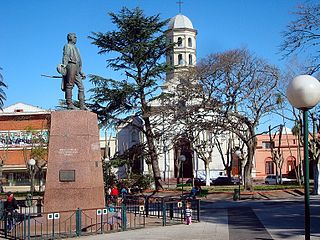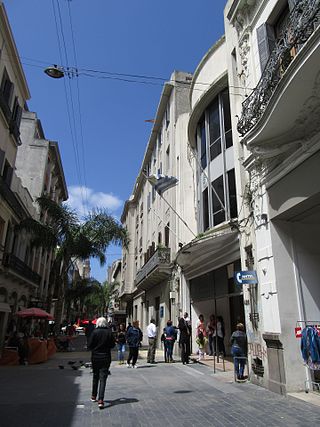The history of Uruguay comprises different periods: the pre-Columbian time or early history, the Colonial Period (1516–1811), the Period of Nation-Building (1811–1830), and the history of Uruguay as an independent country (1830–present).

Montevideo is the capital and largest city of Uruguay. According to the 2011 census, the city proper has a population of 1,319,108 in an area of 201 square kilometers (78 sq mi). Montevideo is situated on the southern coast of the country, on the northeastern bank of the Río de la Plata.

Local government is a generic term for the lowest tiers of governance or public administration within a particular sovereign state.
Ayuntamiento is the general term for the town council, or cabildo, of a municipality or, sometimes, as is often the case in Spain and Latin America, for the municipality itself. Ayuntamiento is mainly used in Spain; in Latin America alcaldía is also for municipal governing bodies, especially the executive ones, where the legislative body and the executive body are two separate entities. In Catalan-speaking parts of Spain, municipalities generally use the Catalan cognate, ajuntament, while Galician ones use the word concello, Astur-Leonese conceyu and Basque udaletxea. Since ayuntamiento is a metonym for the building in which the council meets, it also translates to "city/town hall" in English.
The Departamento de Canelones is one of the 19 Uruguayan departments. With an area of 4,536 km2 (1,751 sq mi) and 518,154 inhabitants, it is located in the south of Uruguay. Its capital is Canelones. Ciudad de la Costa is the largest city by total population and Las Piedras is the largest city with an official census.

Montevideo is a department (departamento) of Uruguay. It is by far the smallest department in area, but also by far the most populated. Its capital is the city of Montevideo, which is also the national capital. While most of the department is covered by the capital city, there are still smaller towns within its limits.

According to the Organic Law of Regional Governments, the regions are, with the departments, the first-level administrative subdivisions of Peru. Since its 1821 independence, Peru had been divided into departments but faced the problem of increasing centralization of political and economic power in its capital, Lima.

Centro is a barrio of Montevideo, Uruguay. Its main axis is 18 de Julio Avenue, and it runs between Plaza Independencia and Ejido St, being the central business district.

The Montevideo Cabildo is the public building in Montevideo that was used as the government house during the colonial times of the Viceroyalty of the River Plate. Today the building is used as a museum and houses the Historical Archive of the city. It is located on Constitution Square, in Ciudad Vieja.

Barrio Sur is a barrio of Montevideo, Uruguay. It borders Ciudad Vieja to the west, the central business district to the north, Palermo to the east and the coastline to the south.

Pando is a city in the Canelones Department of Uruguay. It is an important commercial and industrial centre which has become part of the wider Montevideo metropolitan area.

The Palacio Municipal de Montevideo is the seat of Montevideo government, located on 18 de Julio Avenue, in barrio Centro. It was designed by Uruguayan architect Mauricio Cravotto.

Peatonal Sarandí is an 0.5 miles pedestrian street in Ciudad Vieja, Montevideo, Uruguay. It is the main lane of the historic center, and one of the most touristic sites in the city, due to the fact that it is flanked by different architecturally notable buildings. The pedestrian street starts at the Gateway of the Citadel and ends at its intersection with Peatonal Pérez Castellano, while the remaining four blocks, up to the Rambla, are allowed for vehicles. As an extension of this street is the long southern breakwater of the Port of Montevideo, which has taken on the name "Escollera Sarandí".
A provincial council is the administrator and governing body of a province of Spain. It is one of the entities that make up local government in Spain. The council is made up of a president, vice presidents, an executive committee and the plenary assembly of deputies.
An ayuntamiento is the body charged with the government and administration of the municipalities in Spain not bound to the regime of concejo abierto. The ayuntamiento is one of the bodies charged with Local government in Spain.

Yamandú Ramón Antonio Orsi Martínez is a Uruguayan politician serving as the 24th intendant of the Canelones Department since November 26, 2020. A member of the Movement of Popular Participation – Broad Front, he previously served as the 23rd intendant of Canelones from 2015 to 2020.
Andrés Abt was a Uruguayan politician who served as a member in the Chamber of Representatives and as mayor of Montevideo's CH Municipality.

The Cabildo of Lima was the governing body of Lima and, since 1874, its intendancy. It was created four days after the creation of the city in 1535, existing until its suppression during the independence of Peru in 1821. It was headed by the Alcalde Ordinario.













